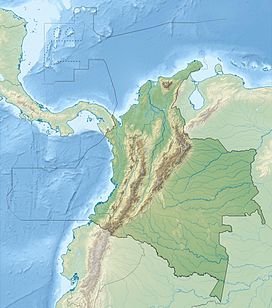The Magdalena River Valley (Spanish: Valle del Río Magdalena) is a valley in Colombia located within the Colombian Andes. The valley is specifically situated between the Central and Eastern Ranges and crossed by the river of the same name, the Magdalena River.
| Magdalena River Valley | |
|---|---|
| Valle del Río Magdalena | |
 Magdalena River in its valley | |
| Long-axis direction | South-north |
| Area | 200.000 km2 |
| Geology | |
| Type | River valley |
| Age | Cretaceous-Holocene |
| Geography | |
| Location | Andean natural region |
| Population centers | Neiva, Barrancabermeja, Barranquilla |
| Borders on | Central Ranges Eastern Ranges Sierra Nevada de Santa Marta Caribbean Sea |
| Coordinates | 7°03′34.9″N 73°51′11.1″W / 7.059694°N 73.853083°W |
| Rivers | Magdalena River |
Geology
editThe Magdalena River Valley was formed after a series of tectonic formed depressions that filled up with continental sediment in the Tertiary period. These sediments came from the Central Ranges of the Colombian Andes.[1] The Magdalena Valley, subdivided into the Upper (VSM), Middle (VMM) and Lower Magdalena Valleys (VIM), is an important area for oil exploration in Colombia.[2]
Flora and fauna
editFlora
editThe first recorded European contact with the potato was in 1537 in the Magdalena Valley. The Spanish invaders became familiar with the crop and it was probably around 1570 when a Spanish ship first introduced potatoes to Europe.[3]
Fauna
editThe Magdalena River Valley is home to a species of butterfly, Magdalena Valley ringlet or Splendeuptychia ackeryi, first identified in 2009.[4] There are many endangered mammals and birds found in the region, including the brown spider monkey and the endemic blue-billed curassow and white-mantled barbet. These species are threatened by habitat loss, among other factors.
References
edit- ^ (in Spanish) Historia de la Geología en Colombia Archived 2007-10-27 at the Wayback Machine
- ^ García, D.F; Parra, P. (2003), Área con Mayor Potencial de Carga de Petróleo: Cuenca Valle Medio del Magdalena (VMM) y Occidente de la Cordillera Oriental, Colombia, Asociación Colombiana de Geólogos y Geofisicos del Petróleo (ACGGP), p. 253, retrieved 2017-03-13
- ^ Simmonds, Norman Willison (1976), Evolution of Crop Plants, Longman, pp. 1–339, ISBN 978-0-582-46678-4, retrieved 2017-03-13
- ^ "Moustache helps identify butterfly". Natural History Museum, London. Archived from the original on February 24, 2009. Retrieved 2015-12-02.
